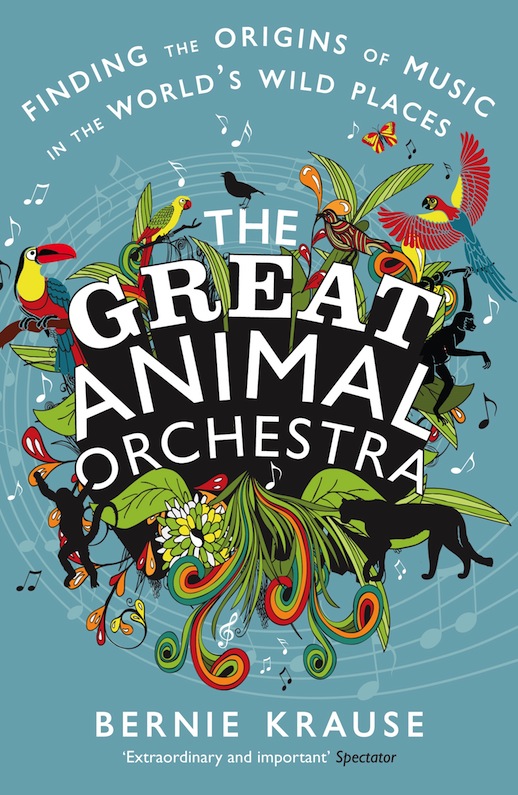THE GREAT ANIMAL ORCHESTRA : Finding the Origins of Music in the World’s Wild Places
by Bernie Krause
Profile Books, 277pp, pbk.
A review by Andy Childs.
One of the most memorable hours of last year’s Port Eliot Festival for me was the one spent listening to Chris Watson’s Nature Disco – an enthralling mix of field recording anecdotes and an array of astonishing sounds from the natural world that only Chris, and a handful of other talented, knowledgable and well-equipped people are able to hear and record. One of these other people is Bernie Krause, who has written this impassioned and absorbing book that attempts to convey the diversity, complexity and importance of natural soundscapes and our relationship to them.
Formerly one half of Beaver & Krause (for record buyers of a certain age) and before that a session guitarist and member of The Weavers, Bernie Krause, now a recognized expert in bioacoustics, defines three basic types of sound – that which is produced by non-human organisms : biophony, non-biological natural sound : geophony, and human-generated sound : anthrophony – and he spends much of this book exploring and reflecting on how these three distinct worlds of sound relate to each other, how these relationships affect our environment, and how we need to seriously re-examine our attitude and appreciation of non-anthrophonic sounds if we are not to ultimately lose large chunks of our aural landscape. As much as anything this book is a warning that these delicately-balanced soundscapes are being suffocated and even obliterated by the growing racket that we humans feel compelled to make, and that their preservation is inextricably linked to the well-being of our global environment.
Unfortunately though, most of us, it seems, are not tuned in sufficiently to fully appreciate the aural splendour of the natural world and even if we were there is only a certain amount we can actually hear with the naked ear. Astonishing as it manifestly is, much of what Mr.Krause describes and enthuses over can only be heard through sophisticated (and expensive) recording equipment – not the kind of tackle that one can slip in the pocket before a stroll along the river bank. In one amusing aside he describes how “pound for pound, one of the loudest organisms in the animal kingdom is, oddly enough, the inch-and-half-long snapping shrimp….which generates a signal with its large claw that can meet or exceed 200 dB underwater – equivalent to 165 dB in air….Indeed the lowly, unsophisticated shrimp will not be outdone even by the Grateful Dead, whose concerts have been measured at levels exceeding 130 dB. Get this Deadheads : the shrimp is louder by close to a factor of five – all that without a huge stack of stage speakers!” My chances of hearing one of these fearsome, ear-splitting shrimps is mercifully remote but there are apparently a multitude of non-human-generated sounds out there that would entrall and illuminate our appreciation of nature, if only we knew how to listen. Our general lack of empathy as a race with our natural surroundings is summed up nicely here by ecologist Bill McKibben : “what sets wilderness apart in the modern day is not that it’s dangerous, or that it’s solitary or full of exotic animals. It’s that five miles out in the woods you can’t buy anything”.
In order to arouse our perception of natural sound Mr.Krause reasons thus : “Dorothea Lange, the Depression-era American photojournalist, used to say that a camera is a tool for learning to see without a camera. Well, a recorder is a tool for learning to listen without a recorder”. And reading his descriptions of the art and science of making field recordings and the way they can elucidate and inform what’s happening in and to the natural world, it’s not hard to see the sense in what he says.
There is fascinating material here on how intrusive noise in the animal kingdom can affect sexual selection, breeding cycles and population dynamics; how underwater sonar waves have such a devastating effect on whales; and studies on how aeroplane noise can disturb the protective chorus of toads and temporarily leave them at the mercy of predators. And a great deal more information that no serious environmentalist or even nature lover can surely ignore. Mr.Krause is no apocalyptic alarmist though. His reasoned advocacy for increased understanding and appreciation of our natural environments and the unique soundscapes they possess is sober, logical and persuasive and as he says in his concluding paragraph “The whisper of every leaf and creature implores us to love and care for the fragile tapestry of the biophony, which – after all – was the first music our species heard. Those messages told us that we weren’t separate but rather essential parts of a single fragile biological system, voices in an orchestra of many, with no more important cause than the celebration of life itself”.
It does help to have some sort of understanding of musical notation and the rudiments of acoustics to fully comprehend the more technical sections of this book where Mr.Krause, entirely legitimately, veers away from the average person’s comprehension (well, mine at least) of “natural sounds” and employs the sometimes bewildering vernacular of American academia. I would also take issue with the badly-printed spectrograms and diagrams in this paperback edition that are almost incomprehensible if you don’t know exactly what you’re looking for. These are in no way criticisms that should deter you from investigating this book though. Its subject matter is consistently fascinating and its message is a critical one. If you were captivated by the last issue of An Antidote To Indifference then The Great Animal Orchestra will go some way to expanding your knowledge and understanding of the astounding and often secret world of nature’s soundscapes.
